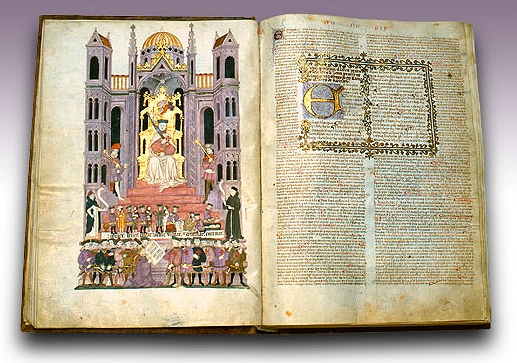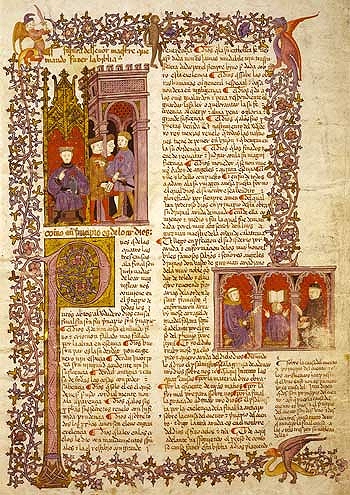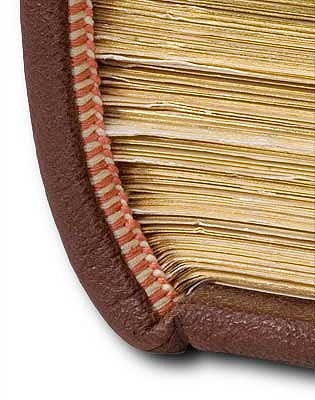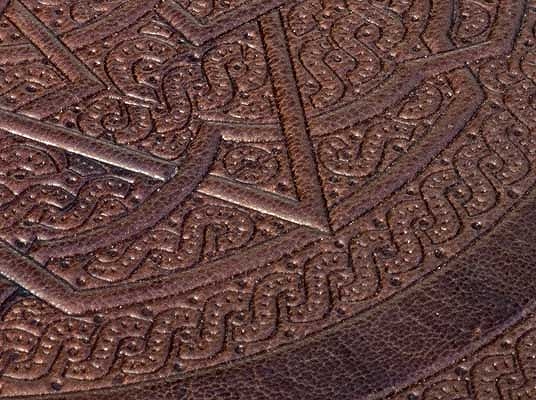
The Alba Bible (Facsimile)

Published by Linda and Michael Falter of Facsimile Editions
The Alba Bible
150 Founders copies bound by Angelo Recalcati, Milan
The Bible
The Alba Bible, with its 513 folios and 334 miniatures, is a powerful work of visual art. But still more significant is the vast commentary it contains. Rabbi Moses showed great independence and courage, and his translation and commentary make few concessions to Christian thinking, although he must have been aware of the dangers awaiting both him and the Jewish community. It is rich in extracts not only from rabbinical writings such as the Targumim, Midrashim and Talmud, but also from later works such as the Zohar - the source book of Jewish mysticism. Rabbi Moses may well have given the artists detailed instructions on the illustrations, furnishing them with specifically Jewish interpretations of biblical scenes. The resulting images are also very important as cultural records, since contemporary weapons, musical instruments, furniture and costumes are all depicted. The cooperation between the Christian patron and the Jewish author-translator makes the Alba Bible a vital element in the ancient and troubled Christian-Hebraic tradition.
Background
In 1992, His Majesty King Juan Carlos of Spain publicly retracted the 500 year old order that signalled the expulsion of the Jews from Spain. It had never formally been repealed. At last, Jews are officially welcomed back to the country from which their ancestors were driven, and old communities re-established, in a sincere bid to undo the evil committed by the Inquisition centuries ago. This extraordinary and unprecedented turn of fate was commemorated by the publication of a magnificent facsimile edition of this unique manuscript. After the Duke of Alba generously offered to allow a facsimile to be made of his masterpiece, the publishers of the Alba Bible facsimile received the following commission from its new patron Señor Mauricio Hatchwell Toledano: "I want the most beautiful facsimile ever produced, no more, no less...". Mauricio Hatchwell Toledano is the moving force behind the International Jewish Committee Sepharad '92, and the founder of the Fundación Amigos de Sefarad of Spain. He decided that the Alba Bible would be a living testament to the spirit of 1992, reviving and fulfilling the long-forgotten hopes of those who had laboured over it five centuries before.
Production of the Facsimile
Unrelenting in his quest for the finest quality, he commissioned Facsimile Editions, to produce the facsimile to hitherto unsurpassed standards, combining the finest materials and the very best craftsmanship.
Its paper, formulated to reproduce the exact feel and opacity of the original parchment, was milled in Italy for the facsimile. The pages of the manuscript were disbound at the Palacio de Liria in Madrid by James Brockman, the Master Bookbinder from Oxford, enabling each folio to be laid flat for photography. Israeli photographer David Harris brought equipment from London and Jerusalem to Madrid in order to photograph the manuscript, using large-format film, especially manufactured in a single batch, and processed at the same laboratory in order to ensure a constant colour balance. Over the following year, colour separators from Milan joined Linda Falter and the printer for regular meetings at the Palace in Madrid, where proofs of each page were compared in every detail with the original, until the finest possible colour-match was achieved.
Every brush-stroke and gold dot was examined and all are reproduced in the facsimile. Michael and Linda Falter stayed in Milan for the entire period of the production, where their team of craftsmen worked under their constant supervision. Echoing the atmosphere surrounding the original making of the manuscript in Maqueda, specialists from all over Europe were brought to Milan, to ensure that the facsimile would match the original as closely as possible.
The Binding
The original binding of the manuscript no longer exists, so a blind-tooled Mudéjar binding, now in Toledo Cathedral and produced in the same time and geographical area as the manuscript, was used as a model for both the facsimile and for a new binding of the original manuscript. Finding morocco goatskins large enough to cover the boards was a daunting task for the binder, Angelo Recalcati, working from his atelier outside Milan.

 |
Miniature 1 - Don Luis de Guzmán sits on the left in a cathedral and hands a letter addressed to 'Rrabi Mose' to one of the three squires standing to the right. The Grand Master raises his right forefinger to alert the squire who holds the letter. A falcon perches on his other hand. The four figures bear the red cross of the Order of Calatrava on their shoulders. The caption to the miniature reads: 'figura del señor maestre que mando fazer la Biblia' (Old Spanish: "picture of the lord master who ordered the production of the bible"). Miniature 2 - Moses Arragel sits between Brother Arias de Ençinas, Father Superior of the Monastery of Saint Francis of Toledo, to the right, and Don Vasco de Guzmán, Archdeacon of Toledo, to the left, with his back turned to the reader. Their forefingers are raised in instruction while he points towards them, discussing the work he is to compose. The Franciscan wears a doctoral hat and the brown habit of his order. The Dominican wears a black cope and holds his doctoral hat in his hand.. |
The head and tail bands for each volume are sewn by hand. |
 |
 |
Special tools were made to recreate the intricate, centuries-old blind-tooling of the binding. |
Facsimile Edition's and their beautiful reproductions can be found at: www.facsimile-editions.com.